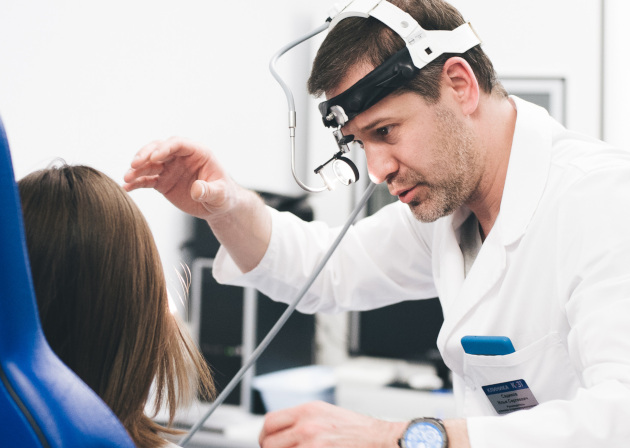Hearing test

specialists

equipment

treatment
What diseases cause hearing loss?
You need to see a doctor for otitis media (inflammation of the middle ear). It can be acute or chronic. Reduced hearing (temporary or permanent) is associated with the accumulation of fluid behind the eardrum.
Noise trauma can also cause problems. Prolonged exposure to loud sounds, such as in the workplace or when listening to loud music, causes irreversible damage to the hair cells in the inner ear.

Other indications for hearing testing include:
- Meniere's disease This is a chronic disease of the inner ear. It is accompanied by attacks of dizziness, tinnitus and progressive hearing loss. The causes of the pathology include abnormal accumulation of fluid in the labyrinth of the ear
- Otomycosis This is an infection caused by yeast or mold fungi. The disease is characterized by damage to the external ear canal. Sometimes the pathological process spreads to the skin of the auricle and the eardrum
- Osteosclerosis The disease is characterized by abnormal growth of bone tissue in the middle ear. This leads to impaired mobility of the bones and hearing loss
- Acoustic neuroma A tumor of the eighth cranial nerve arises from Schwann cells. The neoplasm often causes unilateral deterioration in hearing
- Presbycusis It is a progressive deterioration in hearing, which worsens with age. The main symptom of the pathology is a gradual deterioration of hearing. At the same time, speech perception worsens
- Autoimmune disease of the inner ear (AID) In this disease, antibodies or immune cells attack the inner ear. This leads to a progressive loss of sound perception and often to dizziness. In most cases, there is a significant deterioration in hearing, and then complete deafness
Methods of Hearing Testing
How is hearing tested at the K-31 clinic?
The first stage of examination at the K+31 clinic (Moscow) is a consultation with an otolaryngologist. During the process, the specialist collects anamnesis and clarifies complaints.
After the initial examination, the doctor refers the patient for hardware examination. After all examinations are completed, the doctor conducts a final consultation. In this case, he discusses the results of the examinations with the patient and offers treatment options. If necessary, the otolaryngologist refers the client for further examination to narrow specialists.
Ear examination at the K-31 clinic is carried out using modern equipment. This allows us to guarantee the accuracy of diagnosis and high quality of medical care. To sign up for a hearing test in Moscow, fill out the application form. You can discuss any questions with the center manager by phone.

Answers on questions
How often should your hearing be checked?
People at risk are advised to have their ears checked regularly. This is relevant:
- For babies and teenagers. Periodic testing should be done during regular visits to the pediatrician
- For adults. In the absence of characteristic symptoms, the examination should be done every 3-5 years. In the presence of risk factors, the hearing should be tested once a year
- For older people. Hearing tests should be done annually
Regular examinations allow you to detect problems at an early stage and take timely measures.
How to prepare for a hearing test?
Is it possible to improve your hearing if problems are detected?
There are several ways to improve hearing when disorders are detected. Inflammatory ear diseases are treated with medication (antibiotics or anti-inflammatory drugs are prescribed).
In case of otosclerosis or damage to the eardrum, surgery is performed. If necessary, a person is prescribed modern hearing aids. They help improve the perception of sounds and speech.
The audiologist also selects a rehabilitation program. Special exercises help improve hearing skills and adapt to life with loss of perception.
What ear testing methods are suitable for babies?
Preschoolers and adolescents are prescribed gentle examination methods. These include:
- Otoacoustic emission (OAE). A quick and painless method. In this way, disorders can be identified in a newborn child
- Control of the reaction to sound. During the process, the doctor observes the child's reaction to sound stimuli
- Play audiometry. This method of testing children's hearing is adapted to their perception and age characteristics. During the process, children are asked to perform simple actions, for example, to move objects or show the necessary pictures. This allows you to get information about the child's hearing in a playful environment
Children who already speak well are assigned speech tests for the perception of phrases or individual words and for repeating what they heard. Such studies allow you to assess the child's ability to understand and distinguish words.
Our doctors

How is an appointment with an otolaryngologist at K+31?

This award is given to clinics with the highest ratings according to user ratings, a large number of requests from this site, and in the absence of critical violations.

This award is given to clinics with the highest ratings according to user ratings. It means that the place is known, loved, and definitely worth visiting.

The ProDoctors portal collected 500 thousand reviews, compiled a rating of doctors based on them and awarded the best. We are proud that our doctors are among those awarded.
Make an appointment at a convenient time on the nearest date
Price
Other services






































Indications for hearing testing
A hearing test for adults is often prescribed in the context of ear diseases. The following symptoms indicate a deterioration in hearing function:
Hearing tests are especially important for older people. This is due to the fact that with age, a natural decrease in hearing is observed.